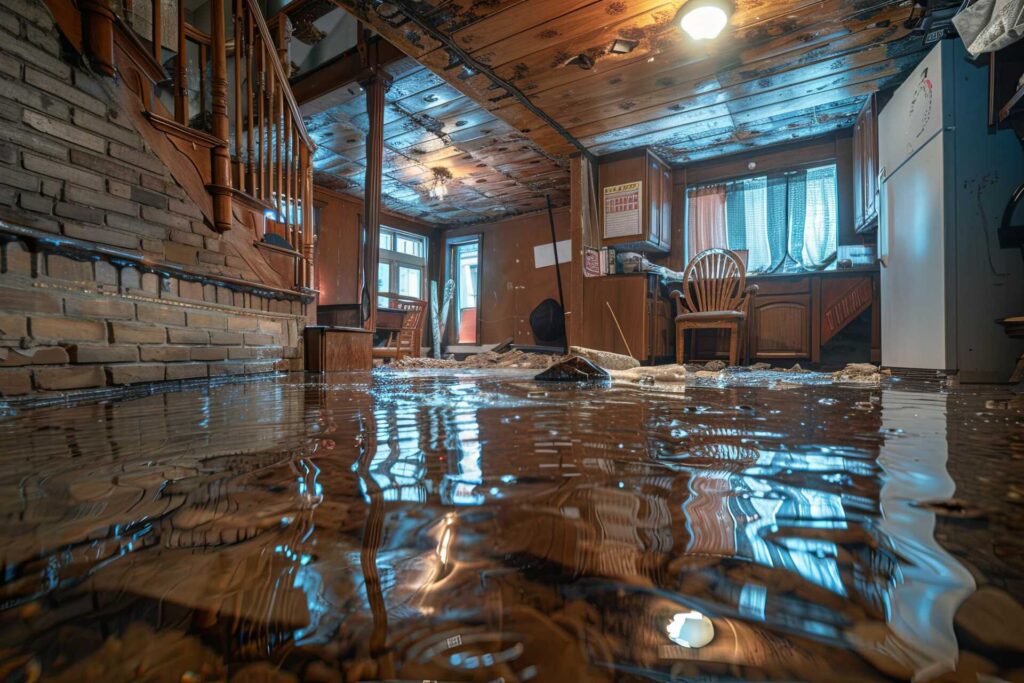
Contents
When it comes to addressing water damage in an environmentally friendly manner, eco-conscious methods are key. By employing techniques such as using biodegradable cleaners, natural drying processes, and sustainable materials, you can make a positive impact on both your surroundings and health. But how exactly do these methods work, and what benefits do they offer beyond just being eco-friendly? Let’s explore the nuances of these eco-conscious water damage repair approaches and how they can elevate your restoration efforts to a whole new level.
Key Takeaways
- Use biodegradable cleaners to minimize impact on water sources and wildlife.
- Employ natural drying methods like solar-powered dehumidifiers for sustainable water extraction.
- Choose sustainable building materials like bamboo flooring and low-VOC paint.
- Implement waste minimization strategies by recycling and proper waste disposal.
- Prioritize eco-friendly mold remediation techniques using natural products like vinegar and tea tree oil.
Green Cleaning Products
When it comes to eco-friendly water damage repair methods, utilizing green cleaning products is an essential step toward minimizing environmental impact. Choosing biodegradable cleaners and non-toxic solutions plays a crucial role in aiding the restoration of your property and safeguarding the well-being of the ecosystem.
Biodegradable cleaners are crafted to naturally break down into harmless substances, reducing the likelihood of harmful chemicals persisting in the environment. These cleaners are formulated to decompose rapidly, lessening their impact on water sources and wildlife. By opting for biodegradable cleaners, you actively contribute to preserving the environment while restoring your space.
Non-toxic solutions are another integral aspect of green cleaning products. These solutions are free from harmful chemicals that could pollute soil or water systems. By utilizing non-toxic products, you protect both your health and the environment. These solutions are gentle yet potent, ensuring a comprehensive cleaning process without compromising eco-friendliness.
When dealing with water damage, selecting green cleaning products is a responsible choice that benefits both your property and the planet. By integrating biodegradable cleaners and non-toxic solutions into your water damage repair process, you’re taking a proactive step towards sustainability and environmental stewardship.
Water Extraction Techniques
Efficient water removal techniques are pivotal in the process of addressing water damage effectively. Removal efficiency plays a vital role in minimizing further harm to your property. Utilizing equipment like high-powered pumps and wet vacuums is key to ensuring sustainable practices during water removal. These tools aid in swiftly eliminating standing water from affected areas, preventing structural issues and mold growth.
When it comes to removal efficiency, the use of specialized tools such as moisture meters and infrared cameras can assist in identifying hidden pockets of water within walls or flooring. By accurately pinpointing these areas, you can target them for removal, reducing the risk of long-term damage.
Incorporating sustainable practices into water removal involves the responsible disposal of eliminated water. Implementing proper filtration systems can help cleanse the water for potential reuse or safe disposal. Additionally, considering the environmental impact of the chemicals used during removal is essential. Opting for eco-friendly, biodegradable solutions can minimize harm to the ecosystem while effectively eliminating water.
Natural Drying Methods
To hasten the drying process and boost efficiency, employing natural drying methods can be a highly effective strategy in alleviating water damage. Here are three eco-friendly techniques worth considering:
Solar-Powered Dehumidifiers: Harnessing the power of the sun, solar-powered dehumidifiers are an excellent choice for drying out spaces affected by water damage. These devices use renewable energy to extract moisture from the air, helping to expedite the drying process without relying on traditional electricity sources.
Rainwater Harvesting: Utilizing rainwater harvesting systems can aid in the drying process by diverting excess water away from the affected area. Collecting rainwater for non-potable uses, such as watering plants or cleaning, helps prevent further water accumulation indoors, allowing the affected space to dry more effectively.
Natural Ventilation: Opening windows and doors to allow for natural airflow is a simple yet effective way to promote drying. By creating cross-ventilation within the space, moisture-laden air is exchanged with drier air from outside, expediting the evaporation process and aiding in the restoration of the affected area.
Incorporating these natural drying methods accelerates the drying process and reduces reliance on conventional energy sources, making it a sustainable and eco-friendly approach to water damage repair.
Energy-Efficient Equipment Usage
Using energy-efficient equipment is essential in minimizing environmental impact during the restoration process. When addressing water damage, employing solar-powered dehumidifiers can greatly reduce energy consumption. These dehumidifiers utilize the power of the sun to operate, decreasing reliance on traditional electricity sources and lowering carbon emissions. Solar-powered dehumidifiers aren’t just eco-friendly but also cost-effective in the long run.
In addition to solar-powered dehumidifiers, efficient ventilation systems play a vital role in energy conservation during water damage repair. Proper ventilation helps in drying out affected areas faster, reducing the need for excessive energy usage. By strategically placing and utilizing efficient ventilation systems, you can expedite the drying process while minimizing energy consumption.
When combining solar-powered dehumidifiers with efficient ventilation systems, you create a sustainable approach to water damage restoration. This combination speeds up the drying process and significantly reduces the environmental impact of restoration efforts. By investing in energy-efficient equipment like solar-powered dehumidifiers and efficient ventilation systems, you contribute to a more sustainable and eco-friendly restoration process.
Sustainable Building Materials
Using sustainable building materials is essential in reducing the environmental impact of water damage repair projects. When selecting materials for repairing water-damaged structures, opting for eco-friendly options can significantly contribute to a greener approach.
Here are three sustainable building materials that can be beneficial in water damage repair:
Recycled Insulation: Choosing insulation made from recycled materials helps decrease the demand for new resources and minimizes waste. Recycled insulation can effectively regulate temperature, improve energy efficiency, and contribute to a healthier indoor environment by reducing the presence of harmful chemicals.
Bamboo Flooring: Bamboo is a fast-growing renewable resource that can be harvested sustainably. Bamboo flooring is durable, attractive, and environmentally friendly. It offers a natural aesthetic appeal while being resistant to water damage and mold, making it an ideal choice for areas prone to moisture issues.
Low-VOC Paint: Volatile organic compounds (VOCs) found in traditional paints can release harmful chemicals into the air, contributing to indoor air pollution. Opting for low-VOC or VOC-free paints when repairing water damage can help maintain good indoor air quality and reduce the environmental impact of the project.
Eco-Friendly Mold Remediation
Amidst the aftermath of water damage, addressing mold growth in an eco-friendly manner is essential for ensuring a sustainable restoration process. When it comes to eco-friendly mold remediation, prioritizing methods such as eco-friendly mold prevention, sustainable mold removal, natural mold mitigation, and green mold restoration can notably reduce environmental impact.
To start, eco-friendly mold prevention involves identifying and fixing any sources of moisture promptly. By addressing leaks, improving ventilation, and controlling humidity levels, you can create an environment less conducive to mold growth. Additionally, utilizing sustainable building materials that resist mold, such as mold-resistant drywall and paints with low volatile organic compounds (VOCs), can help prevent future mold issues.
When mold is already present, opting for natural mold mitigation techniques is key. This includes using eco-friendly mold removal products like vinegar, hydrogen peroxide, or tea tree oil, which are effective in killing mold without harsh chemicals.
Green mold restoration involves restoring affected areas using environmentally friendly practices, such as dry ice blasting or HEPA vacuuming to remove mold spores without harmful residues.
Waste Minimization Strategies
In the process of eco-friendly mold remediation, ensuring minimal waste generation is vital for sustaining environmentally aware restoration efforts. Implementing waste minimization strategies not just reduces the environmental impact but also contributes to a more sustainable approach to water damage repair. Here are three key waste minimization strategies to ponder:
Recycling Practices: Incorporating recycling practices into the water damage repair process allows for the reutilization of materials that would otherwise end up in landfills. By sorting and recycling materials like cardboard, plastic, and metal, you can greatly diminish the amount of waste generated during the restoration process.
Reusable Resources: Utilizing reusable resources such as containers, tools, and equipment helps minimize the need for single-use items. Opting for durable, long-lasting materials that can be used multiple times reduces waste and saves money in the long run.
Sustainable Disposal: Proper disposal of waste materials is essential for eco-conscious techniques. Implementing sustainable disposal methods, like composting organic waste and utilizing designated recycling facilities, ensures that waste is managed in an environmentally friendly manner.
Wrap-Up
By integrating eco-friendly water damage repair methods such as green cleaning products, natural drying techniques, and sustainable building materials, you can restore your property effectively while also playing a role in promoting a healthier environment. Just like a thriving garden nurtured by sustainable practices, your restoration endeavors can blossom into a more environmentally conscious and greener future. So why not opt for the route of environmental stewardship in your water damage repair journey?
Recent Posts
7 Best Eco-Friendly Water Damage Repair Methods
When faced with water damage, you must consider the environmental impact of your repair methods.
Sustainable Water Damage Repair Techniques: A How-To Guide
When faced with water damage in your home, it’s crucial to explore sustainable repair techniques
DIY Home Water Removal Tips for Emergencies
If you’ve ever experienced a burst pipe flooding your basement, you know the panic of
